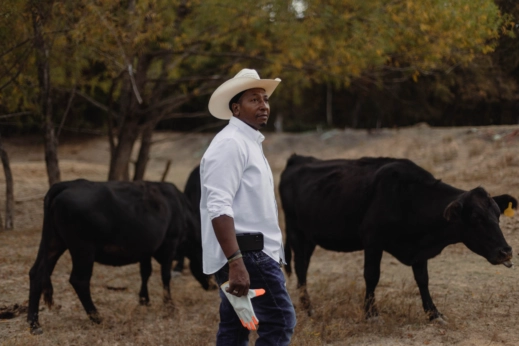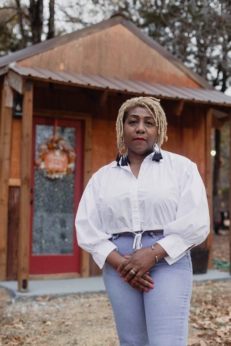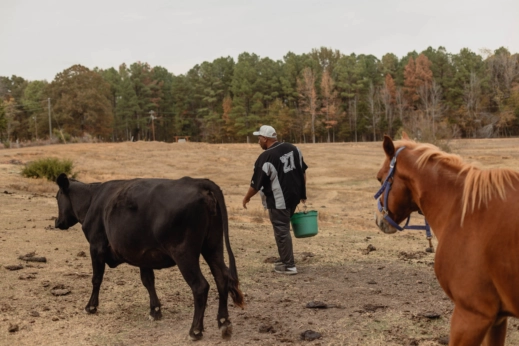Conservation Programs Offer Solutions to Climate Threats, But Are Vastly Underfunded
The Biden administration has called USDA conservation programs a “linchpin” in the nation’s climate strategy.
Conservation Programs Offer Solutions to Climate Threats, But Are Vastly Underfunded
The Biden administration has called USDA conservation programs a “linchpin” in the nation’s climate strategy.

The Johnson family, of central Mississippi, includes, from left to right Albert Johnson Jr., Herman Johnson, Albert Johnson Sr., Charlene Johnson Gatson, Linda Johnson and Flora Johnson Hayes. by Imani Khayyam for the Ag & Water Desk.
When the U.S. Department of Agriculture denied Albert Johnson Sr.’s application for a farm loan in the mid-1980s, he went to a private lender who made him list as collateral all 20 of his cattle and his one bull.
“I stood a chance of losing my livestock,” Johnson wrote in a 1999 affidavit to receive part of a $2.3 billion federal settlement between Black farmers and the USDA.
Johnson, 81, who lives near Lexington, Mississippi, was among thousands deemed to not qualify for settlement money, his family said.
Against all odds, their family farm has persisted, part of the just 1 percent of remaining Black-owned farms in the United States. In an age of mechanized and industrialized agriculture, they face many challenges in operating a sustainable cattle farm—and there’s federal assistance to help with that.
But last month, Johnson’s children learned their application for federal conservation funding was turned down. They had sought up to $30,000 to dig a well and add cross fencing that would have allowed them to do rotational cattle grazing, which protects the soil from erosion.
“It was like ‘here again, another generation’,” said Charlene Gatson, 50, Johnson’s daughter. ”It was like history repeating itself.”
The Biden administration has called such USDA conservation programs a “linchpin” in the nation’s climate strategy, yet they remain vastly underfunded.
Just three out of 10 landowner applications for the two main programs, the Environmental Quality and Incentives Program (EQIP) and the Conservation Stewardship Program (CSP), were approved between 2018 and 2022. The majority of landowners are told to try again without advice on how to improve their odds.

“These are farmers and landowners who want to do conservation on their farm. They want to do something we all seem to support—which is conserving natural resources,” said Jonathan Coppess, an associate professor and director of the Gardner Agriculture Policy Program at the University of Illinois.
Farmers want to improve the environment. Hundreds of thousands of them are applying. “And then you don’t get funding for no other reason than that funding is not sufficient in the program. The level of frustration and anger is pretty real,” said Coppess.
Although the Inflation Reduction Act provided $18 billion more for these in-demand conservation programs, some members of Congress want to claw back that money to pay for the 2023 Farm Bill.
High demand, not enough money
The flagship program of the USDA’s Natural Resources Conservation Service (NRCS) is the program the Johnsons applied for—EQIP—which reimburses agricultural and forestry producers 50 percent to 90 percent of the cost for fixing specific conservation problems and delivering environmental benefits, such as improving water or air quality, enriching soil or protecting against drought.
Between fiscal 2018 and fiscal 2022, the NRCS allocated $6.2 billion for EQIP, but that only covered 31 percent of the nearly 600,000 applications submitted during that five-year period, according to Investigate Midwest’s analysis of application and funding data the USDA provided The Gazette as part of a Freedom of Information Act request.
The Conservation Stewardship Program, created in the 2008 Farm Bill, provides annual payments to producers willing to improve conservation over a five-year period. The NRCS awarded $2.1 billion from fiscal 2018 through fiscal 2022, which covered just 28 percent of applications nationwide.
“EQIP and CSP are working lands programs so they are doing conservation on land that is continuing to produce crops,” Coppess said.
Programs face criticism, but remain the main federally supported solution
Modern agriculture takes a toll on soil and water. Programs like EQIP and CSP are intended to mitigate the damage. A 2020 NRCS report showed EQIP conservation from 2014-2018 increased soil and carbon retained in farm fields as well as provided wildlife habitat.
“Practices funded through EQIP to address forest health and watershed protection on non-industrial private forest land also sequester carbon,” the report found.
The most popular requests for EQIP and CSP funds vary by state. In Iowa and Wisconsin, where corn and soybeans grow, cover crops were by far the most-funded EQIP practice from 2017 through 2020, according to an analysis from the Environmental Working Group. But in Mississippi, with a more diverse farming mix including poultry, livestock and cotton, the EQIP practices that got the most funding were for fencing, grade stabilization structures and irrigation.
Some environmental groups have criticized EQIP for earmarking 50 percent of all funding for livestock practices, Coppess said. Although the U.S. has the world’s largest fed-cattle industry and livestock make up half or more of some states’ ag exports, what if your state isn’t big into pork or beef? Does that mean you get less money? There also are fears it will encourage more large-scale animal production, which can produce large amounts of waste that threatens water sources.
The NRCS allocates money to each state for EQIP and CSP contracts. States then distribute the cash to counties or manage the funds at the state level.
To decide how to spend the limited pot of money for conservation programming, local NRCS officials rank applications on a handful of factors, including how much the practice or activity costs, the magnitude of environmental benefits that could be achieved and how well the practice or activity proposed fits with “national priority resource concerns,” the NRCS reported.
“The ranking process was developed to try to be fair to everyone,” said Scott Cagle, assistant state conservationist for partnerships with the Iowa NRCS. But there are winners and losers and some producers drop out if they don’t get funded right away, Cagle said.
“We run into instances where producers signed up, the process takes too long sometimes and they give up,” he said.
Outreach to Black landowners, others who are underserved
The Johnson family is raising cattle on about 15 of the 200 acres they own near Lexington, Mississippi. During long spells without rain, the grass dries up and the Johnsons have to buy hay. Then the pond dries up and they have to use a hose from the house to water the cows, Gatson said.

If they got EQIP money, they would install cross fencing that would allow them to move cattle around, so plants can regrow between grazings and better protect the soil from erosion. A new well to provide reliable water would cost as much as $20,000.
“We need funding just for the cows to survive,” Gatson said.
The Mississippi NRCS suggested in a Oct. 6 denial letter that the Johnsons “defer” their EQIP application, which puts it back in the pile for the next funding cycle. But Gatson wants to know why their project didn’t rank higher so she can improve the application for next time.
“Could you tell us why some were funded and some were not?” she asked.
NRCS offices across the country have been trying to staff up to provide faster distribution of funds and more help for applicants. A workload analysis for Mississippi NRCS says they need another 55 to 60 employees to meet the need there.
Mississippi conservation officials have been expanding outreach to small producers, including those who haven’t traditionally gotten funding.
“If you look at Mississippi, it has the highest percentage of Black landowners in the nation and that’s around 10 percent,” said James Cummins, executive director of Wildlife Mississippi, a nonprofit that works toward habitat restoration and conservation policy in the state. “We want to see a percentage (of new conservation money) going to help historically underserved producers to help them maintain their family’s land and improve their natural resources.”
Mississippi, a state where agriculture is the No. 1 industry, submitted a whopping 10 percent of all EQIP and CSP applications from fiscal 2018 through fiscal 2022. But despite having the highest number of applications in both programs, only 14 percent of its CSP applications were approved, making it the state with the lowest approval rate relative to its application volume. In the case of EQIP, the state had an approval rate of just 21 percent.

Noemy Serrano is assistant policy director at Michael Fields Agricultural Institute who also works for Wisconsin Women in Conservation, which helps women farmers figure out conservation programs like NRCS. She said recently a farmer who’d received EQIP funding before was confused about whether she could apply again.
“That speaks to the details,” Serrano said. “Even folks that have already applied and been funded through the program sometimes don’t fully understand how it works and how to move forward with it.”
According to USDA data, Wisconsin funded 37 percent of EQIP applications and 35 percent of CSP applications received in fiscal year 2022.
In a perfect world, the NRCS would work with each farmer to make their application more likely to be funded, advocates said.
But because the NRCS staff are so busy, “instead of going out and adding different projects to these applications…they’re not adding that on, because it means more work,” said Sara George, who grows specialty crops near Pepin, Wisconsin.
Cash infusion in jeopardy
Conservation advocates hope a federal cash infusion will reduce the backlog of unfunded projects.
The Inflation Reduction Act, signed by President Joe Biden in August 2022, provides $8.45 billion more for EQIP and $3.25 billion more for CSP starting this year and building through fiscal 2026. This could potentially fund hundreds of thousands more applications. There’s another $300 million to quantify greenhouse gas sequestration.

“We know nationwide that IRA funds will increase” in 2024, said Jamie Alderks, assistant state conservationist for financial assistance programs with the Illinois NRCS. “IRA funds will assist in meeting some of the unmet demand.”
But Republicans in the U.S. House of Representatives want to repurpose that IRA conservation money to help pay for the Farm Bill, which expired in October without being renewed. House Agriculture Chairman Glenn Thompson suggested cutting $50 billion, mostly to climate change and public nutrition programs, to pay for other agriculture programs, such as crop insurance, The Hill reported.
In an Oct. 23 letter published by Politico, 24 Democrats on the House Agriculture Committee pushed back against the idea: “Moving the IRA funds from conservation would be denying farmers the support they need and want.”
Brittney J. Miller of the Gazette contributed to this story, which is a product of the Mississippi River Basin Ag & Water Desk, an independent reporting network based at the University of Missouri in partnership with Report for America, with major funding from the Walton Family Foundation.
Follow us
This work is licensed under a Creative Commons Attribution-NoDerivatives 4.0 International License.
Want to republish a Modern Farmer story?
We are happy for Modern Farmer stories to be shared, and encourage you to republish our articles for your audience. When doing so, we ask that you follow these guidelines:
Please credit us and our writers
For the author byline, please use “Author Name, Modern Farmer.” At the top of our stories, if on the web, please include this text and link: “This story was originally published by Modern Farmer.”
Please make sure to include a link back to either our home page or the article URL.
At the bottom of the story, please include the following text:
“Modern Farmer is a nonprofit initiative dedicated to raising awareness and catalyzing action at the intersection of food, agriculture, and society. Read more at <link>Modern Farmer</link>.”
Use our widget
We’d like to be able to track our stories, so we ask that if you republish our content, you do so using our widget (located on the left hand side of the article). The HTML code has a built-in tracker that tells us the data and domain where the story was published, as well as view counts.
Check the image requirements
It’s your responsibility to confirm you're licensed to republish images in our articles. Some images, such as those from commercial providers, don't allow their images to be republished without permission or payment. Copyright terms are generally listed in the image caption and attribution. You are welcome to omit our images or substitute with your own. Charts and interactive graphics follow the same rules.
Don’t change too much. Or, ask us first.
Articles must be republished in their entirety. It’s okay to change references to time (“today” to “yesterday”) or location (“Iowa City, IA” to “here”). But please keep everything else the same.
If you feel strongly that a more material edit needs to be made, get in touch with us at [email protected]. We’re happy to discuss it with the original author, but we must have prior approval for changes before publication.
Special cases
Extracts. You may run the first few lines or paragraphs of the article and then say: “Read the full article at Modern Farmer” with a link back to the original article.
Quotes. You may quote authors provided you include a link back to the article URL.
Translations. These require writer approval. To inquire about translation of a Modern Farmer article, contact us at [email protected]
Signed consent / copyright release forms. These are not required, provided you are following these guidelines.
Print. Articles can be republished in print under these same rules, with the exception that you do not need to include the links.
Tag us
When sharing the story on social media, please tag us using the following: - Twitter (@ModFarm) - Facebook (@ModernFarmerMedia) - Instagram (@modfarm)
Use our content respectfully
Modern Farmer is a nonprofit and as such we share our content for free and in good faith in order to reach new audiences. Respectfully,
No selling ads against our stories. It’s okay to put our stories on pages with ads.
Don’t republish our material wholesale, or automatically; you need to select stories to be republished individually.
You have no rights to sell, license, syndicate, or otherwise represent yourself as the authorized owner of our material to any third parties. This means that you cannot actively publish or submit our work for syndication to third party platforms or apps like Apple News or Google News. We understand that publishers cannot fully control when certain third parties automatically summarize or crawl content from publishers’ own sites.
Keep in touch
We want to hear from you if you love Modern Farmer content, have a collaboration idea, or anything else to share. As a nonprofit outlet, we work in service of our community and are always open to comments, feedback, and ideas. Contact us at [email protected].by Erin Jordan, The Gazette, Madeline Heim, Milwaukee Journal Sentinel, and Mónica Cordero, Investigate Midwest, Modern Farmer
November 20, 2023
Modern Farmer Weekly
Solutions Hub
Innovations, ideas and inspiration. Actionable solutions for a resilient food system.
ExploreExplore other topics
Share With Us
We want to hear from Modern Farmer readers who have thoughtful commentary, actionable solutions, or helpful ideas to share.
SubmitNecessary cookies are absolutely essential for the website to function properly. This category only includes cookies that ensures basic functionalities and security features of the website. These cookies do not store any personal information.
Any cookies that may not be particularly necessary for the website to function and are used specifically to collect user personal data via analytics, ads, other embedded contents are termed as non-necessary cookies.